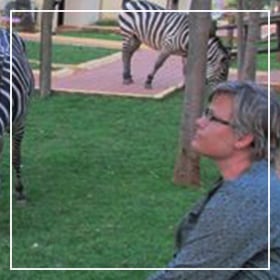Have you ever been in a conference room, listening to one presentation after another, only to realize that they all seemed strangely similar? As in, following the same structure, being read (!) in the same monotonous tone? The words didn’t really come to life in front of your eyes, but rather blended all together into some kind of thick fog. You left the room and looked out the window of the conference building, into the sun, or rain, and the sunrays or the raindrops were so close you could almost touch them, but there was this thick, cold glass between you and life. You felt something was missing, so many things remained unpronounced, caught in the rigid net of academic (re)presentation. You intuitively knew that many of the presenters, too, must have felt somehow unfulfilled. No matter how often they rehearsed the familiar refrain, “it is complicated,” you felt that justice had not been done to the multi-layered experience of fieldwork in which both research participants and researchers feature as multi-faceted human beings. Is there a way to break the mold that constrains academic writing, through that conference building glass that confines us to pro forma stylizations?
With this and other writerly questions in mind, we organized a week-long ethnographic writing workshop for PhDs at the University of Amsterdam, which took place in late May 2016.
Our goal was to shake up ideas and assumptions (or lack of them) about ethnographic writing and presenting, to reflect on the different styles of writing that anthropologists might employ in different contexts, and to reflect on what writing culture might specifically mean to medical anthropologists.
Julie Livingston, author of Improvising Medicine: An African Oncology Ward in an Emerging Cancer Epidemic (2012), kicked off the week with an inspiring lecture to a group of 33 students and staff members that focused on finding a balance between the spectacular and the mundane in ethnographic writing. Using her own work as an example, she demonstrated the ways that attention to detail can help readers to contextualize and make sense of so many of the spectacles we witness when working in places where poverty and precarity shape the realities of health and sickness. In a series of afternoon workshops, she had us crunching numbers, making us re-think where the numbers we use in our texts come from, how are they produced and what they do when we use them in ethnography.
In his lecture, Robert Desjarlais, author of Subject to Death: Life and Loss in a Buddhist World (2016), described in detail his writing method, from collecting data to writing field notes and analyzing them, to the final written outcome. In his workshops, he also challenged us to think about the vision we each had for our writing: in the manner of Italo Calvino and his Six Memos for the next Millennium, which six words would you characterize your ethnography with?
The third lecturer, Eileen Moyer, reminded us to attend to time and space in our texts, and quoted poets and fiction writers to inspire us to think about writing style when reading academic texts as well as fiction and other creative forms. In her workshop, she led us through a process of finding our own voices as writers, to reflect on the conditions we each need to find a flow, and to practice different narrative voices to reach different audiences, be they anthropological, public health or otherwise.

A week of lectures, discussions and concentrated writing time culminated in a morning of ethnographic slam on Friday morning. During the slam, workshop participants were encouraged to present something creative drawing on their anthropological work that they had written during the short, intensive period.
But what is an “ethnographic slam”?
Thinking of a creative way to highlight the work done during the week and to encourage creativity, we proposed an improvised experiment to bring together writing informed by ethnography with the form of a poetry slam, a type of performed poetry. Poetry slam was established in the 1980s by the Chicago poet Marc Smith, who was tired of poetry being trapped within the confines of a small, elitist establishment that made poetry inaccessible to the outside, non-literary world, and also unbearable to listen to at a live reading (sound familiar?). Smith’s solution to passionless, exclusive poetry readings was slam, a vivid, energetic performance in which the poet engages with the audience and together they form a community engaged in a lively dialogue. In the Introduction to his book Take the Mic: The Art of Performance Poetry, Slam and Spoken Word (2009), Smith urges aspiring poets:
Please don’t be one of these soul-sucking zombie poets. Reach deep inside, pull out your pulsing heart, and fling it on the stage. Make the audience listen. Grab it by the throat…figuratively speaking, of course. Use your voice, your eyes, your body, your heart, your soul, and your mind to fire to life the passion, sense, and subtleties of the poetic words you toiled over past midnight, affixing them to the page. Make faces, stomp, gesture, whisper, yell! Do whatever it takes …
Given the enthusiasm and engagement that is invested into such events, it comes as little surprise that poetry slam quickly grew in popularity. First it took over the United States, where it gave rise to poetry slam masters such as Sarah Kay, Robb Q. Telfer, Tim Stafford and Dan Sullivan. Since then it has been spreading ferociously around the world.
The ethnography slam we created at the end of our workshop was meant to take us a similar direction, to break the molds of rigid academic writing and presenting, real and imagined. A written text, performed in a way that makes the audience actually listen, with their whole body, not just the mind. Since this was a new territory for us to explore, there were few rules and instructions, but there were some: Take this opportunity to learn how to take the stage. Keep it short, two to five minutes at the most, but take your time, there’s no need to rush, there won’t be any Q&As, no discussions at the end. Use your body, play with your hands, what can they express that escapes the words? Be creative, use your imagination however you can, let yourself go, just this one time it’s allowed. And if you can find a way to make 33 people laugh at any point, all the better.
As in poetry slam, creativity, imagination and fun were at the core of our ethnography slam, to be used, to paraphrase Marc Smith, as tools to expand rather than limit the possibilities of the written word .[1] But there was one crucial difference between the two. Though initially set up as a variety show, poetry slam has eventually developed into a form of competition, whereby the audience evaluates the performance by clapping and the best poets are finally awarded (“but not always,” reminds us Smith in his book).
In ethnography slam, however, competition was not our focus. We all experience enough of that when we’re applying for scholarships, grants and positions. Even more importantly, competition breeds perfectionism, which is often exactly what curbs creative expression. Instead of trying to be perfect, the ethnography slammers were encouraged to create a ‘safe space’ for each other, a kind of soft cushion, couched in acceptance rather than judgment.
Because the week was intensive—structured around morning craft lectures, afternoon group work and two public keynotes—there was little time to prepare for the ethnography slam. This, and the fact that none of us had ever done an ethnography slam before, created a bit of anxiety: How to choose what to write about? When to find the time to write the text? And how to prepare for the presentation? Working in three smaller groups of eleven people was helpful for many when trying to find answers to those questions. To make the process of choosing the topic of the piece easier, each group chose a theme: Difficulty, Silence, Dialogue. Then, we brainstormed within our groups about the possibilities of what might be included in a presentation: Change of voice? How about some acting? Playing instruments? Showing short clips? Finally, we helped each other fine tune the words we used as well as to practice the performance itself. All this may sound like a lot, but because we had little time, we all managed to pull it off in a couple of hours.

And how did it turn out, in the end? Despite the constraints of time limits and insecurities related to diving into the unknown, the ethnography slammers rose to the challenge brilliantly. Set in a wonderful theatre space on the university campus rather than in a lecture room, the performances brought out laughter, tears, tensions and silences. Surprisingly, many stories dealt with troublesome issues or concerns that ethnographers faced when entering, staying in, or leaving their field. To paraphrase Kristine Krause, one of the ethnography slam performers,
we go out to the field to find certain stories, but we can never think about the kind of stories that will find us.
On the day of the ethnography slam, it was these stories in particular that finally found their outlet.
Cheryl Maddalena (2009: 230), a poetry slammer, writes that while it may begin “with an inspiration and the simple impulse to perform original, heartfelt work on stage,” poetry slam often entails a certain kind of personal transformation.[2] Or, as the poet Natalie Jordan put it, “performing from the heart improves the soul.”[3]
If the ethnography slam had to be described with a single word, “transformative” would certainly be it.
That was how Robert Desjarlais referred to it immediately after the event, and that is what, hopefully, will also become clear from the posts that will be published in this blog series over the coming week. Some of these posts have been slightly edited and adapted from the presentation to the written form. While it might have been best to see these presentations with one’s own eyes, we decided against filming the slam in order to really make it a safe space for personal expression. Publishing online is, of course, a very different endeavor, as the virtual world is far from what could be called a safe space. Nevertheless, we hope that the blog readers will be able to catch some of the energy that ran though that day.
For those curious and courageous enough to try ethnography slam, this is our advice: infuse the event with kindness, have loads of fun, and let yourself be surprised.
[1] Smith, Marc. The Spoken Word Revolution (Slam, Hip Hop & the Poetry of a New Generation). Ed. Mark Eleveld. Naperville: Sourcebooks Mediafusion, 2004 (p. 116).
[2] Maddalena, Cheryl J. “The Resolution of Internal Conflict Through Performing Poetry.” Arts in Psychotherapy 36.4 (2009): 222-230.
[3] I Speak Verbatim; Now Here is the Ultimatum by Natalie “Olivia Moore” Jordan
Featured image by Steve Johnson (flickr, CC BY 2.0)







Tanja, I found this link at the bottom of your medanthnet-good-bye mail, and I am stunned! What a great, great, great idea! I read your (long) article right down to the bottom. This sounds like a great experience, and great fun! Very inspiring. Thank you. Gabriele